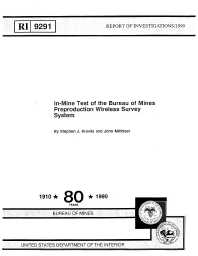Mining Publication: In-Mine Test of the Bureau of Mines Preproduction Wireless Survey System
Original creation date: January 1990
The Bureau of Mines preproduction wireless survey system (WSS) and its performance during an in-mine test are discussed in this report. The WSS was developed to reduce downhole surveying time in order to increase the efficiency of drilling long horizontal methane drainage boreholes in coal. Borehole survey data are electromagnetically transmitted from the downhole guidance probe of the WSS, via the drill rod, to the uphole subsystem in less than 1 min per survey transmission, regardless of borehole depth. The WSS in-mine test consisted of providing borehole survey data during the directional drilling of a 2,538-ft horizontal methane drainage borehole in the Pittsburgh coalbed. By considering available drilling time, which does not include hydraulic drill downtime and the time spent traveling portal to portal, 24 shifts were needed to complete the borehole. Of the available drilling time during the test, 50 pct of the time was spent drilling and 50 pct surveying and maintaining the wss to keep it operational. Previous Bureau experience indicates drilling efficiency was increased 108 pct because of the WSS, in comparison with using a commercially available wire-run directional survey instrument at 10-ft intervals.
Authors: SL Kravits, J Millhiser
Report of Investigations - January 1990
NIOSHTIC2 Number: 10007389
Pittsburgh, PA: U.S. Department of the Interior, Bureau of Mines, RI 9291, 1990 Jan; :1-22
See Also
- Accurate Directional Borehole Drilling: A Case Study at Navajo Dam, New Mexico
- Cableless Electronic Surveying Systems for Horizontal Holes
- Commercial-Quality Gas From a Multipurpose Borehole Located in the Pittsburgh Coalbed
- Drill Monitor With Strata Strength Classification in Near-Real Time
- Evaluations of a noise control for roof bolting machines
- The Evolution of Drill Bit and Chuck Isolators to Reduce Roof Bolting Machine Drilling Noise
- Probability of Encountering Coalbed Discontinuities During Vertical and Horizontal Borehole Drilling
- Rapid Response Rescue Drilling System Development for Mine Rescue Application
- Rotary Drilling Holes in Coalbeds for Degasification
- Sound Power Level Study of a Roof Bolter
- Content source: National Institute for Occupational Safety and Health, Mining Program


 ShareCompartir
ShareCompartir
